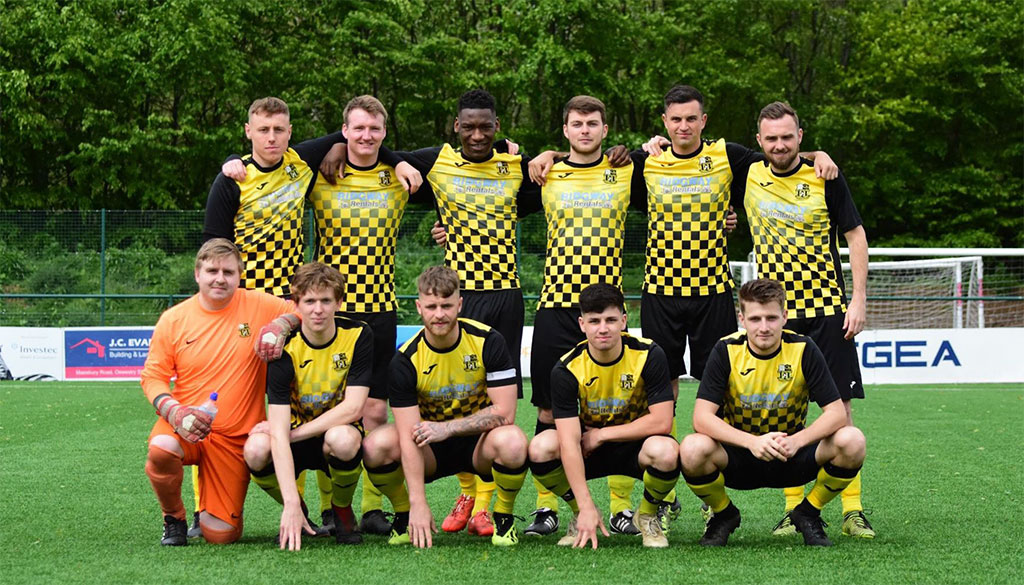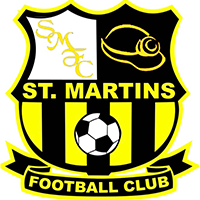
Emblematically Speaking - St Martins
Tue 23rd October 2018 | St Martins | By Stewart Taylor
A quick glance at this emblem tells us all we need to know – or does it? We see a classical shield design clearly indicating that we are looking at a football club.
The club is identified in words and by the initials in the top left hand quadrant of the shield. The incorporation of a football in the bottom half of the shield leaves us in no doubt. Further, the colourways are, as we might expect, representative of the playing colours of the club.
All done? Well, not quite as we see a device in the top right hand quadrant of the shield which needs further explanation and, thus, we have what we might call “a tale of a miner’s helmet”.
Les Williams of St Martins FC takes up the story.
“St. Martins Football Club has a long and illustrious history. As early as 1897 the village had a team competing in the ‘Oswestry & District Football League’ and local competitions.
"Although specific details about the club during this time are vague, the association that the club has with Ifton Colliery is concrete.
"In those early days of the club’s existence, the team spirit and camaraderie was enhanced by the fact that many of the players and committee members worked down the pit at Ifton Colliery so it was deemed appropriate that the Football Club’s emblem badge should proudly display a Miner’s helmet.
“The Miner’s helmets were yellow for the Electricians working in the Colliery, white for the Supervisors at the Colliery and black for those working in the coalface and of course the coal which they were mining was/is black.
"All of these colours are utilised in the club emblem badge and the first team football kit is yellow and black proudly displaying the badge on the shirt.
"This spirit and camaraderie was typified by brothers and fellow Miners, Derek and Travis Stokes who secured a sound partnership at the heart of a sturdy St. Martins F.C defence renowned for its strength and determination and still reminisced by those old enough to remember those special times.”
“This year marks the fiftieth anniversary of the closure of Ifton Colliery in November 1968 and every effort is being made by the Saint Martin’s community to honour those miners who worked at the colliery, particularly those who lost their lives down the pit, so ‘Ifton Colliery Commemorative Project’ is determined to preserve the mining heritage of the village.
"The project agreed to raise £40,000 to pay for the construction of a memorial statue of a Miner wearing a Miners helmet, the replica of which is highlighted on the St. Martins F.C emblem badge.
"The statue is to be constructed in the centre of Saint. Martins and there will be an ‘Ifton Colliery Commemorative Day’ held in the village on 24th November 2018.
“That association between St. Martins F.C and Ifton Colliery is concrete to this day, as ex-Miner, Terry Ellis; Chairman of St. Martins Football Club, is playing a significant role in the commemorative events taking place in Saint Martins to remember the closure of the mine 50 years ago.
"An aspect of that fund raising activity has been a link between ‘Ifton Colliery Commemorative Project’ and the ex England Centre Forward ‘Alan Shearer’ and the ‘Alan Shearer Foundation’. Football fans across the world value Alan Shearer’s lasting legacy as a very special footballer and now are absorbed in what he has to say as a football TV pundit.”
“Alan Shearer has agreed to sign an England shirt that the ‘Ifton Colliery Commemorative Project’ will auction to raise funding for the project but in true spirit of togetherness the project has asked if Alan will also sign a St. Martins F.C. shirt alongside the Miners Helmet emblem badge that the Club will proudly display at every opportunity.”
“For those players who have the privilege of playing for St. Martins F.C this fascinating link between the Football Club and Ifton Colliery represented in the St. Martin’s F.C ‘emblem badge’ provides a poignant interpretation of the term ‘playing for the badge’ .”
A great story and just a reminder, if we needed one, of the significance of local history to football in general and, specifically, the clubs which represent their local community. Such is one of the building blocks of social history.
We are indebted to Les Williams for his contribution to this article. Indeed, as seen, Les wrote most of it.
 Emblematically Speaking - St Martins
Emblematically Speaking - St Martins
Tue 23rd October 2018 | St Martins
By Stewart Taylor

A quick glance at this emblem tells us all we need to know – or does it? We see a classical shield design clearly indicating that we are looking at a football club.
The club is identified in words and by the initials in the top left hand quadrant of the shield. The incorporation of a football in the bottom half of the shield leaves us in no doubt. Further, the colourways are, as we might expect, representative of the playing colours of the club.
All done? Well, not quite as we see a device in the top right hand quadrant of the shield which needs further explanation and, thus, we have what we might call “a tale of a miner’s helmet”.
Les Williams of St Martins FC takes up the story.
“St. Martins Football Club has a long and illustrious history. As early as 1897 the village had a team competing in the ‘Oswestry & District Football League’ and local competitions.
"Although specific details about the club during this time are vague, the association that the club has with Ifton Colliery is concrete.
"In those early days of the club’s existence, the team spirit and camaraderie was enhanced by the fact that many of the players and committee members worked down the pit at Ifton Colliery so it was deemed appropriate that the Football Club’s emblem badge should proudly display a Miner’s helmet.
“The Miner’s helmets were yellow for the Electricians working in the Colliery, white for the Supervisors at the Colliery and black for those working in the coalface and of course the coal which they were mining was/is black.
"All of these colours are utilised in the club emblem badge and the first team football kit is yellow and black proudly displaying the badge on the shirt.
"This spirit and camaraderie was typified by brothers and fellow Miners, Derek and Travis Stokes who secured a sound partnership at the heart of a sturdy St. Martins F.C defence renowned for its strength and determination and still reminisced by those old enough to remember those special times.”
“This year marks the fiftieth anniversary of the closure of Ifton Colliery in November 1968 and every effort is being made by the Saint Martin’s community to honour those miners who worked at the colliery, particularly those who lost their lives down the pit, so ‘Ifton Colliery Commemorative Project’ is determined to preserve the mining heritage of the village.
"The project agreed to raise £40,000 to pay for the construction of a memorial statue of a Miner wearing a Miners helmet, the replica of which is highlighted on the St. Martins F.C emblem badge.
"The statue is to be constructed in the centre of Saint. Martins and there will be an ‘Ifton Colliery Commemorative Day’ held in the village on 24th November 2018.
“That association between St. Martins F.C and Ifton Colliery is concrete to this day, as ex-Miner, Terry Ellis; Chairman of St. Martins Football Club, is playing a significant role in the commemorative events taking place in Saint Martins to remember the closure of the mine 50 years ago.
"An aspect of that fund raising activity has been a link between ‘Ifton Colliery Commemorative Project’ and the ex England Centre Forward ‘Alan Shearer’ and the ‘Alan Shearer Foundation’. Football fans across the world value Alan Shearer’s lasting legacy as a very special footballer and now are absorbed in what he has to say as a football TV pundit.”
“Alan Shearer has agreed to sign an England shirt that the ‘Ifton Colliery Commemorative Project’ will auction to raise funding for the project but in true spirit of togetherness the project has asked if Alan will also sign a St. Martins F.C. shirt alongside the Miners Helmet emblem badge that the Club will proudly display at every opportunity.”
“For those players who have the privilege of playing for St. Martins F.C this fascinating link between the Football Club and Ifton Colliery represented in the St. Martin’s F.C ‘emblem badge’ provides a poignant interpretation of the term ‘playing for the badge’ .”
A great story and just a reminder, if we needed one, of the significance of local history to football in general and, specifically, the clubs which represent their local community. Such is one of the building blocks of social history.
We are indebted to Les Williams for his contribution to this article. Indeed, as seen, Les wrote most of it.


